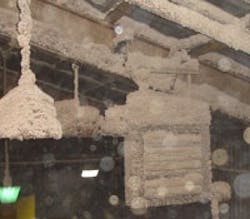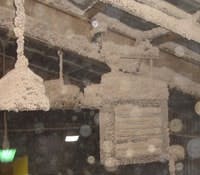Dust Explosion Standard Gets Significant Revisions
The Standards Council of the National Fire Protection Association (NFPA), Quincy, Mass., has issued the 2013 revision of the NFPA 654 "Standard for the Prevention of Fire and Dust Explosions from the Manufacturing, Processing, and Handling of Combustible Particulate Solids." This standard applies to all combustible particulate solids or hybrid mixtures, regardless of concentration or particle size, where the materials present a fire or explosion hazard. The owners or operators of affected facilities are responsible for implementing the requirements.
Dust accumulates and poses a significant hazard. When it's out of sight, it makes it even more dangerous.
The 2013 edition, which now is in effect, incorporates several significant changes, most notably in the areas of housekeeping and establishing whether or not a flash fire or explosion hazard exists within a facility. These changes are particularly important because incident history and statistics clearly indicate that secondary dust explosions, caused by inadequate housekeeping and excessive dust accumulations, have been responsible for much of the damage and casualties experienced in major industrial dust explosions. Other important areas that have been revised or where new requirements have been added include safety management practices such as hazard analysis, management of change, training, emergency procedures, and contractor and subcontractor safety. This article will focus on the changes in administrative requirements.INCIDENT INVESTIGATIONSThere now are requirements for investigating incidents that result in a fire or explosion of a magnitude that causes property damage, production downtime or injury. Section 4.4 of the revised standard mandates preparing a written report that describes the incident, lists what has been learned, and includes recommendations to prevent future occurrences. Additionally, the summary of the report must be shared with affected personnel operating, maintaining and supervising the facility. HOUSEKEEPING PROGRAMSection 8.2 outlines requirements for a formal housekeeping plan; these are tied into the methodologies outlined in Chapter 6 that can be implemented to determine if a dust flash fire or explosion hazard exists inside a plant. Chapter 6 provides four different methods for assessing these hazards.• The Layer Depth Criterion Method. This establishes a baseline combustible dust accumulation based on the dust's bulk density. It adjusts the previous benchmark dust accumulation level (2006 Edition) of 1/32 in., which was based on a dust with a bulk density of 75 lb/ft3, by multiplying 1/32 in. by 75 lb/ft3 and dividing the number by the bulk density of the site's dust to establish a new threshold accumulation thickness. (Thicker layers are allowed for lower density materials.) The total area of nonseparated dust accumulation can't exceed 5% of the footprint area and the total volume in the footprint area can't surpass the layer depth criterion multiplied by 5% of this area. (For areas greater than 20,000 ft2, the maximum accumulations and total volumes are based on a footprint area of 1,000 ft2.) For example, in a room with an area of 1,000 ft2 where dust having a bulk density of 37.5 lb/ft3 has accumulated, the layer depth criteria is 1/16 in. and the accumulation of dust in the room can't surpass 1/16 in. over 50 ft2. Additionally, the total volume of dust in this room can't exceed (1/16 in.)/12 in./ft×50 ft2 = 0.26 ft3 or 9.77 lb.• Mass Methods A and B. Method A relies on an equation to calculate the threshold dust mass accumulation based on floor area and room height. Method B provides a number of parameters, including room area and height, room or enclosure design strength, dust explosibility and entrainment factor. Method B has been adapted from the NFPA 68 "Standard on Explosion Prevention by Deflagration Venting," which adjusts the amount of venting needed when the combustible mixture only fills part of the room and also considers explosion dynamics based on the properties of the dust of interest.• A risk evaluation method acceptable to the authority having jurisdiction. This method affords increased flexibility to an evaluator when assessing the hazard, and supplements the process hazard analysis outlined in Chapter 4. The risk assessment, which must be performed by a competent professional, must show that the proposed strategy will achieve the same result as prescriptive methods. It's based on scientific facts and test data generated on the combustible dust(s). This approach can be a very important alternative to the first three methods for industries that generate significant amounts of combustible dusts due to the inherent nature of their manufacturing operations or where dust control or cleanup may present substantial challenges. The risk-based approach considers the physical, chemical, explosibility and ignitibility properties of a dust as part of the overall risk assessment — for example: Is the combustible dust very difficult to ignite? Does it have very weak explosibility properties? Does the nature of the dust particle (size and shape) make generation of a combustible atmosphere improbable? Is an incendive ignition source likely? These are some of the factors that are considered in determining whether an explosion hazard exists in a plant. Section 8.2 requires implementing a planned inspection process to evaluate dust accumulation rates and housekeeping frequencies to prevent threshold accumulation levels from developing on walls, floors, horizontal surfaces such as equipment, ducts, pipes, ledges, beams, above suspended ceilings and other concealed surfaces, for example, electrical enclosures.The plan also must include requirements establishing time to clean local spills or short-term accumulations, and to allow for the elimination of the spilled mass or accumulations derived from implementation of the Section 6.1 methodologies. Tables in Annex A provide guidance on the time allowed for such cleanup activities. Section 8.2.1.4 mandates performing a documented risk assessment to determine the level of housekeeping consistent with any flash fire or dust explosion protection measures in Section 6.4, Deflagration Venting of the Room, and Section 11.22, Personal Protective Equipment (PPE), if the facility is operated at dust levels that exceed the chosen criterion in Section 6.1. (Chapter 11 includes new requirements for PPE where a room or building is judged to present a dust flash fire or explosion hazard.)TRAINING AND PROCEDURESThree specific areas have received important revisions:• Written emergency response plan. There is a new requirement to develop a written emergency response plan for preventing, preparing for, and responding to work-related emergencies, which include fires and explosions. This plan must be reviewed annually or as required by process changes.• Contractors and subcontractors certification. A significant number of incidents have been attributed to inadequate training of contractors or subcontractors. The owner of the facility ultimately is responsible for the actions of personnel performing activities on its site. The standard now mandates employing only qualified contractors possessing the requisite craft skills for work involving the installation, repair or modification of buildings (interior and exterior), machinery and fire protection equipment. Examples of the skill sets required are provided in the Annex and include applicable American Society of Mechanical Engineers (ASME) stamps and professional licenses. In addition, contractors involved in the commissioning, repair or modification of explosion protection equipment must be qualified as specified in Chapter 15 of NFPA 69, "Standard on Explosion Protection Systems." Basically this requirement includes both training and authorization by the specific explosion-protection-system manufacturer.• Contractor training. The standard now requires that contractors operating owner/operator equipment be trained and qualified to operate the equipment and perform the work. Written documentation must be maintained on the training provided and the individuals trained. In addition, any contractor working on or near a given process must be made aware of potential hazards from exposures to fire, explosion or toxic releases. That individual also must comply with the facility's safe work practices and policies, including (but not limited to) equipment lockout/tagout permitting, hot work permitting, fire system impairment handling, smoking, housekeeping and use of PPE. Contractors also must be trained on the facility's emergency response and evacuation plan, including (but not limited to) emergency reporting procedures, safe egress points and evacuation areas. SIGNIFICANT CHANGESThe 2013 revision of NFPA 654 imposes several new administrative requirements designed to improve safety, including: 1. reporting of incidents; 2. providing PPE for employees working in areas where a flash fire or explosion hazard exists;3. implementing a housekeeping program designed to prevent dust flash fire or explosion hazards in buildings or rooms; 4. developing an emergency response plan; and 5. establishing contractor qualification and training.Familiarity and understanding of these requirements will enable an operator/owner to take the steps necessary to comply with the revised standard. Expert help may be required in some cases.
STEVEN J. LUZIK, PE, CFEI, is senior process safety specialist for Chilworth Technology, Inc., Princeton, N.J. E-mail him at [email protected].

